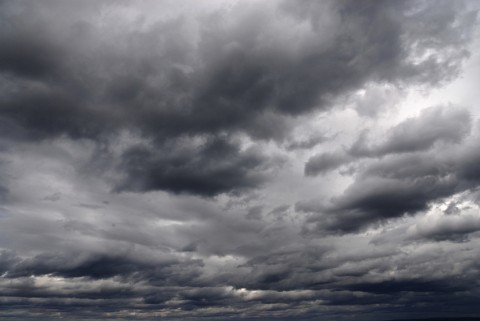Weather is a crucial element in our everyday lives. Not only does it determine whether you can go for a hike or a football match over the weekend, but it also serves as a very good conversation starter. When looking for a solid way to open a conversation with a stranger in Cantonese, weather is almost fail-proof.
Can’t wait to know more about Hong Kong weather? Keep reading!
Table of Contents
- Hong Kong Weather Overview
- Key Words and Phrases about Weather in Cantonese
- Common Sentences to Talk about the Weather
- Bonus: 4 Common Hong Kong Natural Disasters
- How CantoneseClass101.com Can Help You Learn More Cantonese
1. Hong Kong Weather Overview
Falling into the subtropical climate zone, Hong Kong has four seasons: humid spring, rainy summer, invigorating autumn, and cool winter. The average annual temperature is 23°C (73.4°F).
Looking at Hong Kong weather by month, many would agree the best months of Hong Kong weather are November and December, where the temperature is generally comfortable with ample sunshine and pleasant breezes. From May to November, Hong Kong may be subjected to tropical cyclones of various strengths, and occasional showers and thunderstorms.
1- Spring
From March to May marks the spring season in Hong Kong. You can usually expect showers, fog, and steamy humidity. The temperature in spring typically ranges from 18°C to 25°C (64.4°F to 77°F).
The weather throughout the season can be quite unpredictable—sometimes you get to enjoy a clear blue sky; other times, you may experience sudden heavy rain. Still other times, it might get too foggy, which leads to reduced visibility and temporary suspension of ferry services.
If you’re going to travel to Hong Kong for a short trip in the springtime, it’s wise to bring shorts, t-shirts, and rainwear. As it will turn a bit chilly at night, you should bring a light jacket or coat, and a sweater as well.
2- Summer
Summer (June to August) brings unbearable heat, rain, and frequent typhoons to Hong Kong. The average temperature is 28°C (82.4°F), but it can often go up to 32°C (89.6°F) or even higher during the daytime. Little breeze, burning sunshine, and extreme humidity can be a nightmare to both locals and travelers. Be sure to arrive prepared with practical phrases to talk about hot weather in Cantonese, and follow our tips below.
Hong Kong is also due for constant threat of showers, typhoons, and thunderstorms in the summer. June has the highest average rainfall, and heat usually spikes in July or August.
If you’re going to travel to Hong Kong for a short trip in the summer, it’s suggested to bring t-shirts, shorts, and dresses. Don’t forget to bring an umbrella as well, to avoid getting wet in the rain.
3- Autumn
Autumn (September to November; average temperature 24°C or 75.2°F) is probably the best time to visit Hong Kong. During this time of the year, Hong Kong is cool and dry, with ample sunshine and pleasant breezes—perfect for outdoor activities such as hiking on Lamma Island and standup paddleboarding in Sai Kung!
If you would like to visit Hong Kong in lovely autumn, it’s advised to bring t-shirts, a thin overcoat, and a sweater (particularly toward the end of autumn).
4- Winter
Winter in Hong Kong is cool, dry, and cloudy, with occasional cold fronts. The temperature typically ranges from 12°C to 20°C (53.6°F to 68°F), although in recent years, Hong Kong winter has been getting hotter. In 2018, the average temperature went up to 19.1°C (66.4°F) due to global warming and local urbanization.
Still, it’s suggested to bring sweaters, coats, and boots if you’re to visit Hong Kong in the winter months. When a cold front hits Hong Kong, the temperature can drop quickly down to below 10°C (50°F), or even near 0°C (32°F) in the suburbs.
As temperature varies widely in the winter, it’s encouraged to check the Hong Kong Observatory, the Hong Kong government’s weather forecast agency, for up-to-date Hong Kong weather forecasts and tips.
2. Key Words and Phrases about Weather in Cantonese
All of the following examples are in written Cantonese.
1- 温度
Meaning: temperature
Romanization: wan1 dou6
- Example Sentence: 温度計上的溫度是甚麼?
- Romanization: wan1 dou6 gai3 soeng6 dik1 wan1 dou6 si6 sam6 mo1
- Meaning: What is the temperature on the thermometer?
2- 颱風
Meaning: hurricane
Romanization: toi4 fung1
- Example Sentence: 颱風從海洋吹到陸地。
- Romanization: toi4 fung1 cung4 hoi2 joeng4 ceoi1 dou6 luk6 dei6
- Meaning: The hurricane is blowing in from the sea.
3- 風
Meaning: wind
Romanization: fung1
- Example Sentence: 正在刮風,我們回家吧。
- Romanization: zing3 zoi6 gwaat3 fung1, ngo5 mun4 wui4 gaa1 baa6
- Meaning: The wind is blowing; let’s head home.
4- 雨
Meaning: rain
Romanization: jyu5
- Example Sentence: 街上正在下雨。
- Romanization: gai1 soeng6 zing3 zoi6 haa6 jyu5
- Meaning: The rain is falling on the street.
5- 悶熱
Meaning: muggy
Romanization: mun6 jit6
- Example Sentence: 今天非常悶熱。
- Romanization: gam1 tin1 fei1 soeng4 mun6 jit6
- Meaning: Today is very muggy.
6- 濕度
Meaning: humidity
Romanization: sap1 dou6
- Example Sentence: 低濕度令空氣感覺乾燥。
- Romanization: dai1 sap1 dou6 ling6 hung1 hei3 gam2 gok3 gon1 cou3
- Meaning: With low humidity, the air feels dry.
7- 潮濕
Meaning: humid
Romanization: ciu4 sap1
- Example Sentence: 八月很潮濕。
- Romanization: baat3 jyut6 han2 ciu4 sap1
- Meaning: It’s humid in August.
8- 結冰
Meaning: ice over
Romanization: git3 bing1
- Example Sentence: 橋比旁邊的馬路更快結冰。
- Romanization: kiu4 bei2 pong4 bin1 dik1 maa5 lou6 gang3 faai3 git3 bing1
- Meaning: Bridges will ice over before the rest of the roadway.
9- 攝氏
Meaning: Celsius
Romanization: sip3 si6
- Example Sentence: 今天氣溫是攝氏三十度。
- Romanization: gam1 tin1 hei3 wan1 si6 sip3 si6 saam1 sap6 dou6
- Meaning: Today’s temperature is 30 degrees Celsius.
10- 雪
Meaning: snow
Romanization: syut3
- Example Sentence: 下雪的森林。
- Romanization: haa6 syut3 dik1 sam1 lam4
- Meaning: The snow is falling in the woods.
11- 彩虹
Meaning: rainbow
Romanization: coi2 hung4
- Example Sentence: 我看見秀麗的彩虹。
- Romanization: ngo5 hon3 gin3 sau3 lai6 dik1 coi2 hung4
- Meaning: I saw a scenic rainbow.
12- 放晴
Meaning: clear up
Romanization: fong3 cing4
- Example Sentence: 我在等天氣放晴。
- Romanization: ngo5 zoi6 dang2 tin1 hei3 fong3 cing4
- Meaning: I am waiting for the sky to clear up.
13- 結冰
Meaning: freeze
Romanization: git3 bing1
- Example Sentence: 水在玻璃上結冰。
- Romanization: seoi2 zoi6 bo1 lei1 soeng6 git3 bing1
- Meaning: The water froze on the glass.
3. Common Sentences to Talk about the Weather
To inquire about the weather:
Chinese Character: 天氣點呀?
Meaning: How’s the weather?
Romanization: tin1 hei3 dim5 aa1
Breakdown: 天氣 means “weather,” 點 means “how,” and 呀 is the question mark particle.
To answer the question:
1- 我覺得好熱
Meaning: I feel very hot.
Romanization: ngo5 gok3 dak1 hou2 jit6
Breakdown: 我 means “I,” 覺得 means “feel,” 好 means “very,” and 熱 means “hot.”
2- 我覺得好凍
Meaning: I feel very cold.
Romanization: ngo5 gok3 dak1 hou2 dung3
Breakdown: 凍 means “cold.”
3- 我覺得今日好潮濕
Meaning: I feel very humid today.
Romanization: ngo5 gok3 dak1 gam1 jat6 hou2 ciu4 sap1
Breakdown: 今日 means “today” and 潮濕 means “humid.”
4- 可能會落雨
Meaning: Perhaps it’ll rain.
Romanization: ho2 nang4 wui5 lok6 jyu5
Breakdown: 可能 means “perhaps,” 會 means “will,” and 落雨 means “rain.”
5- 今日太曬喇
Meaning: It is too sunny today.
Romanization: gam1 jat6 taai3 saai3 laa3
Breakdown: 太 means “too,” 曬 means “sunny,” and 喇 is the particle.
To inquire about the temperature:
Chinese Character: 今日幾多度呀?
Meaning: How’s the temperature today?
Romanization: gam1 jat6 gei2 do1 dou6 aa3
Breakdown: 幾多 means “how many,” 度 means “temperature,” and 呀 is the question mark particle.
To answer the question:
Chinese Character: 今日三十二度
Meaning: It’s 32 degrees Celsius today.
Romanization: gam1 jat6 saam1 sap6 ji6 dou6
Breakdown: 三十二 means “thirty-two” and 度 means “degrees Celsius.”
4. Bonus: 4 Common Hong Kong Natural Disasters
Typhoon — Hong Kong is frequently hit by typhoons in summer, causing varying degrees of damage and, on rare occasions, injuries and deaths. The typhoon warning system using the designations T1, T3, T8, and T10, indicates the degree of storm intensity.
Landslide — The Hong Kong Observatory and the Geotechnical Engineering Office issue a landslide warning whenever there’s a high risk of landslides due to heavy rainfall.
Flood — Hong Kong sees very heavy rainstorms and has one of the highest average rainfall amounts of all the cities in the Pacific Rim. During particularly heavy storms, floods often occur in rural low-lying areas and natural flood plains.
Wildfire — On average, Hong Kong experiences over 10,000 wildfires each year, which injure or take the lives of more than 600 people. Most wildfires are the result of carelessness or negligence.
Learn more about Hong Kong natural disasters here.
5. How CantoneseClass101.com Can Help You Learn More Cantonese
We hope you’re now much more familiar with Hong Kong weather! Are seasons and weather talk similar in your own country, or very different? Let us know in the comments!
Fancy visiting Hong Kong in the refreshing autumn and want to put some basic Cantonese in your pocket? With CantoneseClass101.com, you can have your daily dose of Cantonese whenever and wherever you want, through mobile apps, desktop software, and our website. We offer entertaining, engaging, and effective lessons on various aspects of the Cantonese language and culture.
Until now, we’ve delivered more than 750,000,000 lessons to thousands of happy students from all around the globe. You can learn Cantonese with over 1060 audio and video lessons delivered by our knowledgeable and energetic hosts, detailed PDF lesson notes, an abundance of vocabulary learning tools, spaced repetition flashcards, and a lively community to discuss the lessons with fellow learners. What are you waiting for? Download our lessons, enjoy our audio and video files, and start learning now!
And keep in mind that if you prefer a one-on-one learning approach and want to further accelerate your Cantonese learning, you can take advantage of our MyTeacher program!
Know that your hard work will pay off, and before you know it, you’ll be speaking Cantonese like a native!


















